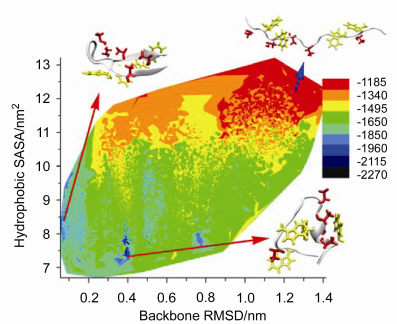| [1] Bryngelson, J. D.; Onuchic, J. N.; Socci, N. D.; Wolynes, P. G. Proteins 1995, 21, 167. [2] Karplus, M.; Šali, A. Curr. Opin. Struct. Biol. 1995, 5, 58. [3] Bian, L.; Yang, X.; Liu, L. Acta Chim. Sinica 2005, 63, 1081. (边六交, 杨晓燕, 刘莉, 化学学报, 2005, 63, 1081.) [4] Yang, F.; Liang, Y.; Yang, F. J. Acta Chim. Sinica 2003, 61, 803 (杨芳, 梁毅, 杨芳(小), 化学学报, 2003, 61, 803.) [5] Zhou, J.; Thorpe, I. F.; Izvekov, S.; Voth, G. A. Biophys. J. 2007, 92, 4289. [6] Thorpe, I. F.; Zhou, J.; Voth, G. A. J. Phys. Chem. B 2008, 112, 13079. [7] Dobson, C. M. Nature 2003, 426, 884. [8] Hansmann, U. H. E. Chem. Phys. Lett. 1997, 281, 140. [9] Kinnear, B. S.; Jarrold, M. F.; Hansmann, U. H. E. J. Mol. Graphics Modell. 2004, 22, 397. [10] Hansmann, U. H. E. J. Chem. Phys. 2004, 120, 417. [11] Hansmann, U. H. E.; Wille, L. T. Phys. Rev. Lett. 2002, 88, 68105. [12] Sugita, Y.; Okamoto, Y. Chem. Phys. Lett. 1999, 314, 141. [13] Zhang, J.; Qin, M.; Wang, W. Proteins: Struct., Funct., Bioinf. 2006, 62, 672. [14] Munoz, V.; Thompson, P. A.; Hofrichter, J.; Eaton, W. A. Nature 1997, 390, 196. [15] Chen, C.; Xiao, Y. Bioinformatics 2008, 24, 659. [16] Zhou, R. Methods Mol. Biol. 2006, 350, 205. [17] Xie, Y.; Zhou, J.; Jiang, S. Y. J. Chem. Phys. 2010, 132, 065101. [18] Earl, D. J.; Deem, M. W. Phys. Chem. Chem. Phys. 2005, 7, 3910. [19] Zhou, R.; Berne, B. J.; Germain, R. Proc. Natl. Acad. Sci. U. S. A. 2001, 98, 14931. [20] Zhou, R. Proc. Natl. Acad. Sci. U. S. A. 2003, 100, 13280. [21] Zhou, R. J. Mol. Graphics Modell. 2004, 22, 451. [22] Haliloglu, T.; Kolinski, A.; Skolnick, J. Biopolymers 2003, 70, 548. [23] Chen, J.; Won, H. S.; Im, W.; Dyson, H. J.; Brooks, C. L. J. Biomol. NMR. 2005, 31, 59. [24] La Penna, G.; Mitsutake, A.; Masuya, M.; Okamoto, Y. Chem. Phys. Lett. 2003, 380, 609. [25] Vreede, J.; Crielaard, W.; Hellingwerf, K. J.; Bolhuis, P. G. Biophys. J. 2005, 88, 3525. [26] Jas, G. S.; Kuczera, K. Biophys. J. 2004, 87, 3786. [27] Gnanakaran, S.; Hochstrasser, R. M.; García, A. E. Proc. Natl. Acad. Sci. U. S. A. 2004, 101, 9229. [28] Antoine, R.; Compagnon, I.; Rayane, D.; Broyer, M.; Dugourd, P.; Breaux, G.; Hagemeister, F. C.; Pippen, D.; Hudgins, R. R.; Jarrold, M. F. J. Am. Chem. Soc. 2002, 124, 6737. [29] Chebaro, Y.; Mousseau, N.; Derreumaux, P. J. Phys. Chem. B 2009, 113, 7668. [30] Cecchini, M.; Rao, F.; Seeber, M.; Caflisch, A. J. Chem. Phys. 2004, 121, 10748. [31] Lu, Y.; Wei, G.; Derreumaux, P. J. Phys. Chem. B 2011, 115, 1282. [32] Cochran, A. G.; Skelton, N. J.; Starovasnik, M. A. Proc. Natl. Acad. Sci. U. S. A. 2001, 98, 5578. [33] Du, D.; Zhu, Y.; Huang, C. Y.; Gai, F. Proc. Natl. Acad. Sci. U. S. A. 2004, 101, 15915. [34] Juraszek, J. Ph.D. Dissertation, University of Amsterdam, Amsterdam, 2008. [35] Olsen, K. A.; Fesinmeyer, R. M.; Stewart, J. M.; Andersen, N. H. Proc. Natl. Acad. Sci. U. S. A. 2005, 102, 15483. [36] Wei, H.; Shao, Q.; Gao, Y. Q. Phys. Chem. Chem. Phys. 2010, 12, 9292. [37] Rathore, N.; Chopra, M.; De Pablo, J. J. J. Chem. Phys. 2005, 122, 024111. [38] Rao, F.; Caflisch, A. J. Chem. Phys. 2003, 119, 4035. [39] Zhang, W.; Wu, C.; Duan, Y. J. Chem. Phys. 2005, 123, 154105. [40] Sindhikara, D.; Meng, Y.; Roitberg, A. E. J. Chem. Phys. 2008, 128, 024103. [41] Sindhikara, D. J.; Emerson, D. J.; Roitberg, A. E. J. Chem. Theory Comput. 2010, 6, 2804. [42] Katzgraber, H. G.; Trebst, S.; Huse, D. A.; Troyer, M. J. Stat. Mech.: Theory Exp. 2006, 2006, P03018. [43] van der Spoel, D.; Lindahl, E.; Hess, B.; van Buuren, A. R.; Apol, E.; Meulenhoff, P. J.; Tieleman, D. P.; Sijbers, A. L. T. M.; Feenstra, K. A.; van Drunen, R.; Berendsen, H. J. C. Gromacs User Manual, version 4.5, 2010, www.gromacs.org. [44] Darden, T.; York, D.; Pedersen, L. J. Chem. Phys. 1993, 98, 10089. [45] Essmann, U.; Perera, L.; Berkowitz, M. L.; Darden, T.; Lee, H.; Pedersen, L. G. J. Chem. Phys. 1995, 103, 8577. [46] Berendsen, H. J. C.; Postma, J. P. M.; Van Gunsteren, W. F.; DiNola, A.; Haak, J. J. Chem. Phys. 1984, 81, 3684. [47] Shaytan, A. K.; Shaitan, K. V.; Khokhlov, A. R. Biomacromolecules 2009, 10, 1224. [48] Marsh, J. A.; Teichmann, S. A. Structure 2011, 19, 859. [49] Lins, L.; Thomas, A.; Brasseur, R. Protein Sci. 2003, 12, 1406. [50] Periole, X.; Mark, A. E. J. Chem. Phys. 2007, 126, 014903. [51] Jang, S.; Kim, E.; Pak, Y. Proteins 2007, 66, 53. [52] Blanco, F. J.; Rivas, G.; Serrano, L. Nat. Struct. Mol. Biol. 1994, 1, 584. Zagrovic, B.; Sorin, E. J.; Pande, V. J. Mol. Biol. 2001, 313, 151. |
